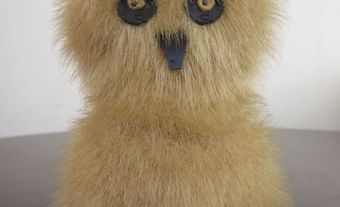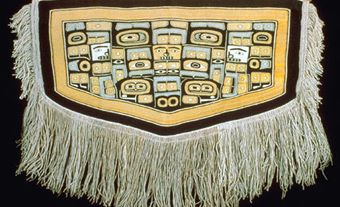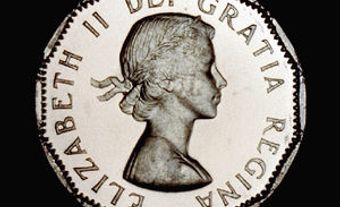Clothing
The colonization of eastern Canada began with the French in the 17th century. For some years, these settlers depended for clothing on what they brought with them. New garb was expensive and the only clothing available was ready-made garments made locally from imported cloth or, sometimes, from dressed skins. Weaving did not become widespread in the new settlement until early in the 18th century; some local manufacture of fashionable shoes and hats had begun by the late 17th century.
Fashionable Dress
With the appearance of towns, affluent male and female inhabitants dressed in elegant clothing similar to that worn in France. However, there was a time lag of at least a year between the initiation of a style in Europe and its appearance in Canada, since ships from the continent came only annually. In 17th-century Canada a fashionable male wore a wig, rich fabrics and elegant lace. Portraits of Jean Talon, the first intendant of New France, show him stylishly attired in a wig, brocade dressing gown, shirt lavishly trimmed with lace at the wrists, and lace cravat.
In 1703 Madame Riverin, wife of a member of Quebec City's Conseil Souverain, was painted in a stylish dress called a mantua and an elegant head-dress known as a fontange. Her daughters were dressed similarly and her son was garbed in a miniature version of fashionable male clothing. Such imitation of adult clothing was customary in children's attire.
When the province of Upper Canada was created in 1791, the newly formed governing class, as well as the other members of the elite, also attempted to maintain fashionable standards of dress. These standards, like those of English dress, were generally more conservative than the modish styles of 18th-century Paris.
The first Canadian fashion plate, a magazine illustration displaying the most recent fashions, which appeared in March 1831 in the Montreal Monthly Magazine, probably was inspired by one in an English or French publication. With the improvement in overseas communication that occurred in the mid-19th century, the time lag between new European fashions and their appearance in Canada was substantially reduced, becoming as short as two months.
Everyday Dress
All but the wealthiest settlers wore clothing made in the home, often of cloth spun in the home and woven domestically or by professional local weavers. Styles tended to be conservative and to reflect rural French or, later, English styles. In the mid-19th century, as more ready-made clothing became available, fashion slowly became more accessible to the masses; however, most working-class attire continued to be made at home.
Relatively small quantities of this clothing have survived because, as it wore out, it was recycled into quilts and rugs. In 1884 the first mail-order catalogue, the T. Eaton Company pamphlet, appeared, making recent styles more accessible to everyone, even in remote rural areas. This important development decreased the difference between conservative rural and up-to-date fashionable dress.
Men's Clothing
In the early French colonial period, many of the garments worn by ordinary townsmen and male country dwellers (mostly farmers) were similar to those worn in France. In the 17th and 18th centuries these settlers would have worn a variety of garments, sometimes broadly echoing fashionable ones but of a simpler, more utilitarian cut and fabric.
During the 19th century, similar garments continued to be worn but variety was more limited; everyday clothes were principally reminiscent of fashionable garments. Traditional breeches, which ordinarily reached slightly below the knee, were replaced by trousers, and waist-length jackets were common. Beginning early in the 19th century, imported manufactured English cloth increasingly replaced homespun in everyday dress.
Certain types of non-fashionable attire for men, during both the French and English colonial periods (and sometimes persisting later), were different from their counterparts on the continent. Everyday clothing had been influenced by Aboriginal garb, such as the French Canadian's domestically manufactured leather attire, including footwear with a moccasin shape (bottes or souliers sauvages) and leather or fabric leggings. These garments were especially common among country dwellers and those actively involved in the fur trade (eg, coureurs de bois). They were adopted as protection against harsh weather and rough countryside. The moccasin-type footwear (mandatory for snowshoes) was used by all habitants.
Also of interest were the decorative, high-crowned felt hats, trimmed with ostrich feathers, worn by the voyageurs during the early 19th century. Voyageurs also frequently wore the ceinture fléchée, a woollen, finger-woven (a manual technique of braiding or plaiting commonly used by Aboriginal people in North America) multicoloured sash with arrowhead motifs. This characteristic French Canadian accessory first appeared generally in the early 19th century and continued to be finger woven in Quebec until late in the century.
The ceinture fléchée, or arrow sash, was also worn by habitants, used as a trade item in the fur trade and, eventually, adopted for sports and leisure wear by the bourgeoisie, especially with the blanket capot. It has undergone a revival and is again produced in Quebec.
The Quebec capot (in the 17th century the term generally referred to a cloak and, later, to a greatcoat or heavy overcoat) developed slowly in response to the harsh winters. Beginning in the second quarter of the 18th century, it could also have a hood. Often, for country wear, it was made from thick, grey, homespun étoffe du pays.
From the 1770s hooded capots were made in Quebec from Hudson's Bay Company blankets and became a typical costume for the rural Canadian. They were white, with blue bands from the blanket near the hemline and matching bands near the wrist. They had an upright collar and were closed in front by a series of ribbon ties in red, blue or both colours.
A coat could be trimmed with ribbon rosettes in red or blue. This picturesque dress was usually worn with a multi-coloured wool sash, a red wool toque (lined in white) or fur cap, leggings (mitasses) and bottes or boots.
In the 19th century, the blanket capot changed slightly to echo broadly the fashionable greatcoat of the time: buttons and epaulettes were added, ribbon decoration disappeared and different colour combinations in the textile appeared. During this period, the bourgeois adopted the capot for winter sports and leisure wear, and women began to wear a version of the garment.
The attire, especially in white, remains a characteristic one for Québec. Now known as the Hudson's Bay Company coat, it is manufactured in Canada for both sexes. Fur was also important to both men and women for combatting the winter cold. From the mid-19th century on, it was generally worn fur side out, creating a luxurious effect.
Women's Clothing
For ordinary and rural wear during the 17th century, and through to the late 19th century in Quebec, women generally wore separate tops and skirts. In the 17th century and until the second half of the 18th century, corset bodices (approximately waist length and usually sleeveless), chemises (knee-length undergarments which could function for the working classes as blouses), petticoats (skirts), aprons and caps were worn. This costume resembled attire seen in France and throughout Western Europe.
With the appearance of hand-weaving, which used manually operated looms, in New France, plain and checked or striped homespun cloth prevailed. Sometime during the mid-18th century, the traditional corset bodice was replaced by a sleeveless one extending beyond the waist. With its possible stylistic variations, unknown today, it was referred to at the time as a short gown or jacket, and was worn primarily to create the impression of a slim appearance. Still, women’s attire in colonial Canada was shaped by the often rough conditions. In the late 18th century, Lady Simcoe found the iron ring pattens (wooden clogs with iron rings affixed to the bottom) she brought back from England useless on muddy, unpaved roads; she replaced them with the flexible moccasins worn by Indigenous people. Through the 19th century, the attire of women of wealth and position closely followed that of Europe. The elegant dresses worn by the Robinson sisters in George Theodore Berthon’s well-known The Three Robinson Sisters (1846), with their wide skirts and modest embellishment, are virtually indistinguishable from similar British portraits of the same era.
As the 20th century progressed, the dominant development was the gradual change in the supplier of clothing from the dressmaker to the department store. Yet, for wealthy clients, high-fashion dressmakers continued, for a time, to operate successfully in large cities. Such clients were served in the post-WWII period, in Montreal, through couturiers (stylish, high-quality dressmakers running expensive establishments), who modelled their operations on those of French couture salons. In Canada this type of operation persists, but in a reduced form. Distinctively Canadian design began later in the 20th century, when local manufacturing facilities began to make use of their own designers.
Most provincial museums display some pioneer clothing, and excellent collections are held at the Royal Ontario Museum, the McCord Museum of Canadian History and the Fashion History Museum.
See also Fashion Design; Uniforms.

 Share on Facebook
Share on Facebook Share on X
Share on X Share by Email
Share by Email Share on Google Classroom
Share on Google Classroom


